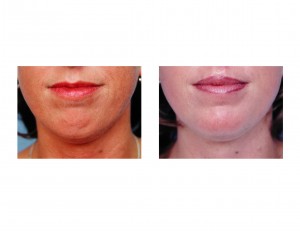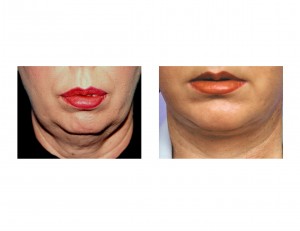Chin deficiency or shortness of the chin in the horizontal direction often contributes to two soft problems, mentalis strain and lower lip incompetence. There may well be other anatomic factors that add to these problems, but the short and backward rotated chin is definitely a major factor. Lip incompetency is obvious as the lips do not meet at rest and an open mouth look may be present. Mentalis strain, as a result of the lips trying to come together, is evident by the dimpled and irregular appearance of the chin as the lips strain to come together.
Mentalis strain and lower lip incompetence are linked but not always mutually present. Both can exist separately without the effect of the other. Mentalis muscle deformities almost always require a shortness of the bony position of the chin. Lower lip incompetence can exist for a variety of reasons without a short chin, most commonly as a consequence of prior chin surgery with soft tissue ptosis and intraoral vestibular scarring.
In the bony chin deficiency, mentalis muscle strain can be present but the bony deficiency must be more than a few mms. Usually it is at least 5 to 6mms or more. With chin augmentation, this muscle abnormality can usually be eliminated. There can be a debate as to whether a chin implant or a chin osteotomy can best improve the muscular problem. Having done a lot of both in my Indianapolis plastic surgery practice, I have seen good results with either approach.
Theoretically, a chin implant merely pushes up the muscle but that movement does stretch it. I think that if mentalis muscle strain is present without lower lip incompetence, then an implant will work fine. I would have no confidence that an implant can push up the lower lip as well. Conversely, an osteotomy also stretches out the muscle but it also allows the muscle to be repositioned up higher as well. (since it is initially cut and then reattached) The act of muscle resuspension and intraoral closure will likely have an improved effect on lower lip incompetence, particularly if it is done well.
Mentalis muscle strain can be observed in some female facelift patients with a short chin. Adding an implant is the only acceptable method of chin augmentation for almost all facelift patients. Their chin deficiencies are usually smaller and only pose an aesthetic issue. Lower lip incompetence is not common in this patient group.
In those patients with lower lip incompetence and a short chin, one may need to consider some type of lip procedure as well. These could include lip volumetric fill with fat, a transverse fascial or implant suspension, or even a wedge excision in severe cases. Whether these should be part of the chin procedure or are better off awaiting that outcome is a matter of debate and severity of the problem.
Dr. Barry Eppley
Indianapolis, Indiana




